New car features
HIGH-TECH FEATURES ON NEW CARS
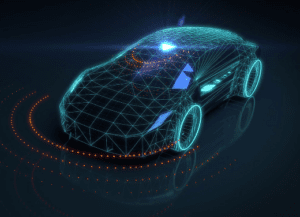
The automotive industry has come a long way in the past few years, and there is no stopping in sight. With the introduction of electric and autonomous cars, cutting-edge safety features, and driver-assist technologies, the future of automotive tech is looking brighter than ever. In this article, we will take a closer look at the latest trends and developments in the automotive industry.
Driving into the Future: What’s New in Automotive Tech?
Electric cars have taken the automotive world by storm and for a good reason. They are not only eco-friendly but also fun to drive and require less maintenance. With more manufacturers joining the electric bandwagon, we can expect to see more affordable and efficient electric cars in the future.
Another significant development in automotive tech is the rise of autonomous cars. Although they are not yet fully self-driving, we can expect to see more advanced driver-assist technologies that make driving safer and more comfortable. Features such as lane departure warnings, adaptive cruise control, and blind-spot monitoring are already available in many new cars, and we can expect to see more of these features in the future.
Buckle Up and Get Ready for the Ride of a Lifetime!
The future of automotive tech is exciting, and there are plenty of new features and technologies to look forward to. One of the most promising developments is the incorporation of augmented reality into the driving experience. With AR, drivers can receive real-time information about their surroundings, traffic, and weather conditions, making driving safer and more comfortable.
Another exciting development is the use of artificial intelligence and machine learning to enhance the driving experience. With AI, cars can learn the driver’s preferences and driving habits and adjust accordingly, making the driving experience more personalized and enjoyable.
In conclusion, the future of automotive tech is looking brighter than ever, and we can expect to see more advanced and innovative features in the coming years. From electric cars to autonomous driving and augmented reality, the automotive industry is constantly evolving, and we are in for an exciting ride. So buckle up and get ready for the ride of a lifetime!
The Future of Automotive Tech
Lane-keep assist
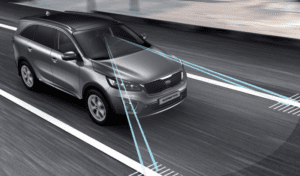
Lane-keep assist is a driver assistance technology designed to help drivers maintain their vehicle within the bounds of their lane on the road. It is often used in modern vehicles to enhance safety and reduce the risk of unintentional lane departure, which can lead to accidents and collisions. Lane-keep assist systems typically rely on various sensors and cameras, as well as control systems, to achieve their function. Here’s how it generally works:
- Sensors and Cameras: Lane-keep assist systems use sensors and cameras mounted on the vehicle to monitor the vehicle’s position within the lane. These sensors can detect the lane markings on the road, typically using visual recognition technology.
- Monitoring: The system continuously monitors the vehicle’s position relative to the lane markings. It can detect if the vehicle is drifting out of its lane without the turn signal activated, which suggests unintentional lane departure.
- Alerting the Driver: When the system detects that the vehicle is drifting out of the lane, it can provide warnings to the driver. This warning may come in the form of visual or audible alerts, such as flashing lights, steering wheel vibrations, or beeping sounds.
- Corrective Action: In some more advanced systems, lane-keep assist can also take corrective action to help keep the vehicle within the lane. This is typically done by applying steering input to gently guide the vehicle back into the center of the lane.
It’s important to note that lane-keep assist is not a fully autonomous driving system. The driver is still expected to maintain control of the vehicle and stay engaged with the driving process. Lane-keep assist is part of a suite of driver assistance features designed to enhance safety and reduce driver fatigue.
The specific capabilities and effectiveness of lane-keep assist systems may vary between different vehicle models and manufacturers, and they are often found in vehicles equipped with more advanced safety and driver-assistance technologies.
Virtual exterior mirrors
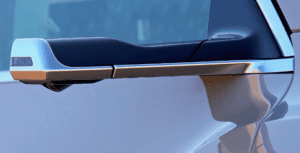
Virtual exterior mirrors, also known as digital or camera-based mirrors, are a modern technology used in some vehicles to replace traditional side mirrors with cameras and digital displays. Instead of physical mirrors mounted on the vehicle’s doors, virtual exterior mirrors use small cameras to capture images of the area around the vehicle, and these images are displayed on screens inside the vehicle’s cabin, typically located near the door or on the dashboard. This technology offers several advantages over traditional mirrors:
- Improved Aerodynamics: Virtual mirrors can be sleeker and more streamlined than traditional mirrors, reducing aerodynamic drag and improving fuel efficiency. This design choice can contribute to better overall vehicle performance.
- Reduced Blind Spots: Virtual mirrors can provide a wider field of view compared to traditional mirrors, reducing blind spots and improving driver visibility, especially in situations such as lane changes or parking.
- Adjustable Views: Drivers can often customize the view from the virtual mirrors by adjusting camera angles and zoom levels, allowing them to optimize their view based on driving conditions and personal preferences.
- Enhanced Visibility: In low-light conditions or bad weather, virtual mirrors can use features like night vision or image enhancement to provide better visibility, potentially improving safety.
- Reduced Distractions: Virtual mirrors may be integrated into the vehicle’s infotainment system or displayed on dedicated screens. They can be more intuitive to use, reducing the need for the driver to physically adjust mirrors while driving.
- Information Integration: In some cases, virtual mirrors can overlay additional information on the display, such as turn signal indicators or blind spot warnings, making it easier for the driver to interpret their surroundings.
While virtual exterior mirrors offer several advantages, there are also some potential downsides, including cost, susceptibility to damage, and the need for drivers to adapt to the new technology. The adoption of virtual mirrors varies by manufacturer and vehicle model, and regulations governing the use of virtual mirrors may differ by region. It’s important to check with the specific manufacturer and the local regulations in your area to understand the availability and usage of virtual exterior mirrors in your vehicle.
DROWSINESS DETECTOR

A drowsiness detector, also known as a drowsiness detection system or driver drowsiness monitoring system, is a technology designed to alert drivers when they exhibit signs of drowsiness or fatigue while operating a vehicle. Drowsy driving is a significant safety concern, as it can lead to impaired reaction times, decreased vigilance, and an increased risk of accidents. Drowsiness detectors are intended to mitigate this risk by monitoring the driver’s behavior and physiological cues and providing warnings when drowsiness is detected. Here’s how they typically work:
- Monitoring Driver Behavior: Drowsiness detection systems use a combination of sensors and data analysis to monitor the driver’s behavior and actions. Commonly monitored parameters include steering input, vehicle speed, lane-keeping behavior, and turn signal usage.
- Facial Recognition and Eye-Tracking: Some advanced systems incorporate cameras to track the driver’s face and eyes. They monitor factors such as eyelid droopiness, blink rate, and head movements to detect signs of drowsiness.
- Physiological Monitoring: In some systems, physiological sensors may be used to detect drowsiness. These sensors can measure physiological changes, such as heart rate or brainwave activity, which are associated with drowsiness.
- Warning Alerts: When the system detects signs of drowsiness or inattention, it provides warnings to the driver. These warnings can be visual (e.g., a flashing icon on the dashboard), audible (e.g., an alarm or voice alert), or haptic (e.g., seat vibrations or steering wheel feedback).
- Adaptive Systems: Some drowsiness detectors are adaptive, meaning they can adjust the intensity of warnings based on the severity of the detected drowsiness. For instance, if the driver is only mildly fatigued, the system might issue a subtle warning, but for more severe drowsiness, it could issue a stronger alert.
It’s important to note that drowsiness detectors are a part of a larger suite of advanced driver assistance systems (ADAS) and should not be relied upon as a substitute for responsible driving practices. They are designed to assist and alert the driver but do not replace the need for a well-rested and attentive driver.
Drowsiness detection systems are becoming increasingly common in newer vehicles, particularly in high-end and luxury models. They are a part of efforts to enhance safety on the road by addressing the dangers of drowsy driving. However, the effectiveness of these systems can vary depending on the manufacturer and the specific technology used.
SURROUND VIEW CAMERA SYSTEM
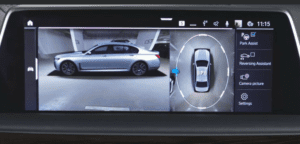
A Surround View Camera System (SVCS), also known as a 360-degree camera system or bird’s-eye view camera system, is a technology commonly found in modern vehicles that provides a comprehensive view of the vehicle’s surroundings. The system typically employs multiple cameras positioned around the vehicle to create a composite, top-down view or bird’s-eye view, along with other perspectives, such as front, rear, and side views. These cameras work together to give the driver a clear and detailed view of the area around the vehicle, enhancing safety and assisting in parking and low-speed maneuvers. Here’s how it typically works:
- Multiple Cameras: A typical Surround View Camera System consists of four or more cameras positioned on the vehicle, typically in the front grille, side mirrors, and rear.
- Image Stitching: The images captured by each camera are processed and stitched together by a central computer to create a composite view of the vehicle’s surroundings. This top-down view is often displayed on the vehicle’s infotainment screen.
- Various Views: In addition to the bird’s-eye view, the system can display individual camera views, including front, rear, and side views. Drivers can switch between these views to get a clear picture of specific areas around the vehicle.
- Parking Assistance: The Surround View Camera System is particularly useful when parking. It helps drivers navigate into tight spaces, avoid obstacles, and maintain a safe distance from curbs or other vehicles.
- Object Detection: Some systems are equipped with object detection features that highlight or provide warnings for obstacles, pedestrians, or other vehicles in the vicinity of the car.
- Guidelines: The system often provides dynamic guidelines on the display to assist the driver in aligning the vehicle correctly while parking. These guidelines adjust as the steering wheel is turned.
- Low-Speed Maneuvering: The Surround View Camera System is most beneficial at low speeds, such as when parallel parking, pulling into a garage, or navigating crowded spaces.
- Safety Enhancement: In addition to parking assistance, the system can enhance safety by helping drivers detect potential blind spots or obstructions while moving at low speeds.
This technology is increasingly common in modern vehicles, especially in higher-end and luxury models, but it is also becoming more prevalent in mainstream vehicles. It is a valuable driver-assistance feature that can improve safety and convenience by providing a comprehensive view of the vehicle’s surroundings, making parking and low-speed maneuvers easier and less stressful.
PEDESTRIAN DETECTION
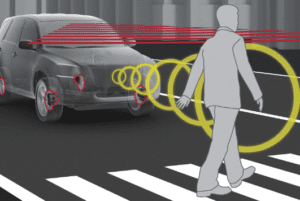
Pedestrian detection is a technology used in modern vehicles to identify and track pedestrians in or near the vehicle’s path, providing a critical safety feature. This technology is typically part of advanced driver assistance systems (ADAS) and is designed to enhance safety by alerting the driver and, in some cases, autonomously applying the brakes to prevent or mitigate collisions with pedestrians. Here’s how pedestrian detection typically works:
- Sensors: Pedestrian detection systems use a combination of sensors and cameras to monitor the area in front of the vehicle. These sensors can include radar, lidar, and especially cameras, which are essential for visual recognition of pedestrians.
- Image Processing: The cameras capture images of the surroundings, and the system’s software processes these images in real-time. The system identifies objects that resemble pedestrians using algorithms and computer vision techniques.
- Object Classification: The system distinguishes pedestrians from other objects, such as vehicles or stationary obstacles. It considers factors like size, shape, movement, and other characteristics to classify objects as pedestrians.
- Tracking: Once a pedestrian is detected and classified, the system tracks their movements to predict their trajectory. This tracking allows the system to anticipate potential collision scenarios.
- Warnings and Interventions: When the system predicts a collision risk with a pedestrian, it can provide warnings to the driver. These warnings can be visual (e.g., warnings on the dashboard), audible (e.g., alarms or voice alerts), or haptic (e.g., steering wheel or seat vibrations). In more advanced systems, the technology can also take autonomous action by applying the vehicle’s brakes to prevent or mitigate a collision with the pedestrian.
- Low-Light and Adverse Conditions: Many pedestrian detection systems are equipped with features to operate effectively in low-light conditions or adverse weather, such as fog, rain, or snow.
Pedestrian detection is a crucial safety feature as it helps reduce the risk of pedestrian-related accidents, which can be particularly severe. This technology is part of a broader effort to enhance road safety and is often integrated into vehicles with other ADAS features such as adaptive cruise control and lane-keeping assist. It’s important to note that the effectiveness of pedestrian detection systems can vary between vehicle models and manufacturers, and they are not a replacement for an attentive and responsible driver. Drivers should always remain vigilant and follow traffic rules to ensure the safety of pedestrians and other road users.
VEHICLE SUMMON FEATURE

The vehicle summon feature, often referred to simply as “Summon,” is a technology available in some modern electric and autonomous vehicles that allows the vehicle to move short distances autonomously, typically with the driver’s remote control or a smartphone app. It’s a part of advanced driver assistance and self-driving technology designed to make it more convenient for drivers to park or retrieve their vehicles. Here’s how it generally works:
- Remote Control: The vehicle summon feature is typically activated using a smartphone app or a key fob. The driver can use the app or a specific command to instruct the vehicle to move autonomously.
- Maneuvering: Once activated, the vehicle can perform various movements, such as moving forward, backward, or turning its wheels, to navigate in tight spaces. This allows it to park in a crowded parking lot, exit a garage with limited space, or simply come closer to the driver.
- Object Detection: The system is equipped with sensors, such as cameras, ultrasonic sensors, and radar, to detect obstacles in the vehicle’s path. If an obstacle is detected, the vehicle will stop or maneuver around it to avoid a collision.
- Line-of-Sight: The driver typically needs to keep the vehicle within their line of sight and within a certain range for safety purposes. The system may not operate if the driver moves too far from the vehicle.
- Precise Control: The summon feature can be fine-tuned for precise control, allowing the driver to guide the vehicle into a specific parking space or to align it with a garage opening.
- Safety Measures: Safety is a paramount concern, and summon features are designed to operate cautiously. The system often has a low maximum speed and can stop immediately if any obstacle is detected.
It’s important to note that the availability and functionality of the vehicle summon feature may vary by vehicle manufacturer and model, as well as local regulations. The driver is typically responsible for monitoring the vehicle and ensuring it operates safely. The summon feature is a convenience feature, but it is not a fully autonomous driving capability. Drivers should always follow safety guidelines and be prepared to take control of the vehicle if necessary.
Tesla’s “Smart Summon” and other similar features offered by automakers are examples of this technology, and it is continually evolving with advancements in autonomous driving systems.
MAGIC BODY CONTROL
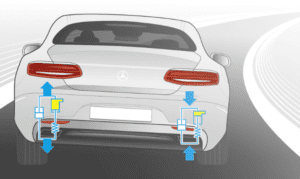
Magic Body Control is a trademarked technology developed by Mercedes-Benz for their high-end S-Class luxury sedans. It is an advanced suspension system that utilizes innovative technologies to provide a smoother, more comfortable ride by adapting to road conditions and the vehicle’s speed. Here are the key features and components of Magic Body Control:
- Stereo Camera System: The heart of Magic Body Control is a stereo camera system mounted on the front windshield. This camera scans the road ahead and captures images of the road surface.
- Road Surface Scan: The camera continuously analyzes the road surface for imperfections, such as bumps, potholes, and undulations.
- Suspension Adjustment: Based on the real-time data from the camera system, Magic Body Control adjusts the suspension settings for each wheel individually. This includes adjusting the damping characteristics of the shock absorbers.
- Predictive Control: What sets Magic Body Control apart is its predictive control system. It can anticipate road surface irregularities up to 45 feet ahead. As a result, it adjusts the suspension proactively to make the ride as smooth as possible, even before the wheels encounter a bump or uneven terrain.
- Curve Tilting Function: In addition to providing a smooth ride on uneven roads, Magic Body Control offers a curve tilting function. When the vehicle enters a curve, the suspension on the side of the vehicle with the outside wheels will be adjusted to reduce body roll, making the ride more comfortable for passengers.
- Comfort and Sport Modes: The system often includes selectable driving modes, such as “Comfort” and “Sport.” In Comfort mode, the focus is on providing a smooth and comfortable ride. In Sport mode, the suspension adjusts for a firmer and more dynamic driving experience.
Magic Body Control is a notable example of innovative suspension technology, and it’s particularly appreciated in the luxury automotive segment where ride comfort and refinement are highly valued. However, it’s important to note that this technology is typically available in higher-end Mercedes-Benz models like the S-Class and is not a standard feature in all vehicles. The specific capabilities and features may vary depending on the model year and trim level of the vehicle.
Night vision systems
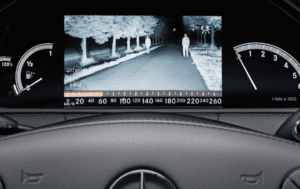
Night vision systems in cars are advanced technologies designed to improve nighttime driving visibility and safety. These systems use infrared (IR) sensors and cameras to detect and display objects and obstacles on the road that may not be easily visible with standard headlights. Here’s how car night vision systems typically work:
- Infrared Sensors or Cameras: Night vision systems use infrared sensors or cameras, which are sensitive to heat and emit their own infrared light.
- Infrared Illumination: To enhance visibility, these systems emit infrared light onto the road ahead. The reflected infrared light from objects and obstacles is then captured by the sensors or cameras.
- Image Processing: The collected infrared data is processed by the system’s computer or processor. It translates this data into an image or video feed, usually displayed on a screen in the vehicle’s dashboard or instrument cluster.
- Display: The resulting image or video feed typically displays on the vehicle’s dashboard, often as a black-and-white or grayscale image. This image may show the road ahead, including pedestrians, animals, and other vehicles.
- Warning and Alerts: Some systems are equipped with object recognition and can provide visual or audible warnings to the driver when they detect potential obstacles or pedestrians in the vehicle’s path.
- Complementary to Headlights: Night vision systems are designed to complement standard headlights, not replace them. While they can help detect objects beyond the range of headlights, they do not emit visible light to illuminate the road like headlights do.
Night vision systems are especially useful for improving visibility in low-light or nighttime driving conditions, reducing the risk of accidents caused by poor visibility, and enhancing overall driver awareness. These systems are commonly found in high-end and luxury vehicles, although they are gradually becoming available in more mainstream models.
It’s important to note that while night vision systems are valuable safety features, they are not a substitute for responsible and attentive driving. Drivers should continue to use their headlights and exercise caution when driving at night or in low-light conditions, even when a night vision system is present.
ABS and SRS meaning
As drivers, our number one priority is always safety on the road. Thankfully, modern technology has given us tools to improve our safety while driving. Two of these important safety features are ABS and SRS.
In this article, we’ll explore what ABS and SRS are, what they do, and why they’re essential for your car’s safety. So buckle up and enjoy the ride while we take you on a journey through the ABCs of ABS and SRS.
The ABCs of ABS and SRS: Your Guide to Car Safety
When it comes to car safety, two acronyms that you’ll often hear are ABS and SRS. ABS stands for Anti-lock Braking System, while SRS stands for Supplemental Restraint System.
ABS is designed to prevent the wheels from locking up while braking, which can cause skidding and loss of control. It works by monitoring the speed of each wheel and adjusting the brake pressure as needed. This means that even if you slam on the brakes, your car will still remain stable and under control.
SRS, on the other hand, refers to the airbag system in your car. Airbags are an essential part of your car’s safety system, and in the event of a collision, they can save your life. The SRS system works by monitoring various sensors throughout your car and triggering the airbags if necessary.
Buckle Up and Enjoy the Ride: Understanding ABS and SRS
Now that you know what ABS and SRS are, it’s important to understand why they’re essential for your car’s safety.
ABS can help prevent accidents by keeping your car stable and under control, even in emergency braking situations. This means that you’re less likely to lose control of your car and end up in a collision.
SRS, on the other hand, can save your life in the event of a collision. Airbags work by cushioning your body and preventing it from hitting the hard surfaces inside your car. Without airbags, you would be much more susceptible to serious injury or even death in a collision.
So there you have it, the ABCs of ABS and SRS. By understanding these important safety features, you can feel more confident and secure on the road. Remember to always buckle up, drive safely, and enjoy the ride!
Electronic Stability Program (ESP):
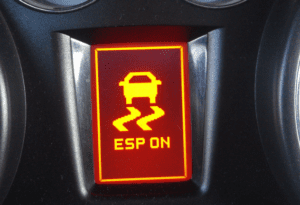
Electronic Stability Program (ESP), also known as Electronic Stability Control (ESC), is a safety feature in modern vehicles designed to help drivers maintain control of their vehicles, especially in challenging driving conditions or emergency maneuvers. ESP uses sensors and advanced technology to detect and mitigate instances of skidding or loss of control, enhancing vehicle stability and safety. Here’s how ESP works and why it’s beneficial:
How Electronic Stability Program (ESP) Works:
- Sensor Inputs: ESP continuously monitors various aspects of the vehicle’s performance through a network of sensors. These sensors include wheel speed sensors, steering angle sensors, yaw rate sensors, and lateral acceleration sensors.
- Detecting Loss of Control: The system assesses data from these sensors to determine if the vehicle is experiencing a loss of control. This can occur when the vehicle starts to skid or slide, indicating that it’s not following the intended path.
- Intervention: If ESP detects that the vehicle is deviating from the driver’s intended direction, it intervenes to help regain control. It does this primarily by selectively applying the brakes to individual wheels and, in some cases, adjusting engine power.
- Individual Wheel Braking: ESP can apply the brakes to specific wheels independently to counteract oversteer (when the rear of the vehicle begins to slide out) or understeer (when the front of the vehicle doesn’t respond to steering inputs). By applying brake force to one or more wheels, ESP can help redirect the vehicle back onto the intended path.
- Engine Power Reduction: In addition to braking, ESP can reduce engine power if necessary to prevent wheel spin and regain traction. This can help stabilize the vehicle during acceleration.
- Assisting During Swerves and Skids: ESP can assist the driver when making rapid lane changes or avoiding obstacles by applying brake force and adjusting engine power to keep the vehicle stable and under control.
Benefits of Electronic Stability Program (ESP):
- Enhanced Safety: ESP is a significant safety feature that helps prevent accidents by reducing the likelihood of skidding, sliding, or spinning out of control, particularly in adverse road conditions.
- Improved Handling: ESP improves a vehicle’s handling and stability, making it easier for the driver to maintain control, especially during sudden maneuvers or evasive actions.
- Reduced Risk of Rollover: ESP can help prevent rollovers by stabilizing the vehicle during sharp turns or swerves.
- All-Weather Performance: It enhances traction and control in various weather conditions, including rain, snow, and ice, reducing the risk of accidents.
- Mitigating Overcorrection: ESP can help mitigate situations where a driver overcorrects while trying to regain control, which can lead to a loss of stability.
- Compatibility with Anti-Lock Brakes (ABS): ESP works in conjunction with anti-lock braking systems (ABS) to further improve vehicle stability.
- Standard Feature: In many regions, ESP has become a standard feature in new vehicles due to its proven safety benefits.
Electronic Stability Program (ESP) is a valuable safety feature that contributes to safer driving experiences by helping drivers maintain control of their vehicles in challenging and emergency situations. It’s particularly effective in reducing the risk of accidents related to loss of control and is now widely available in many modern vehicles.
Adaptive Cruise Control
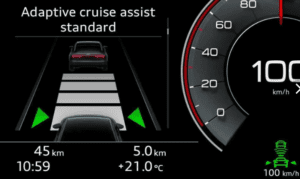
Adaptive Cruise Control (ACC) is an advanced driver assistance system (ADAS) that enhances traditional cruise control by automatically adjusting a vehicle’s speed to maintain a safe following distance from the vehicle ahead. It is also known by other names like “Active Cruise Control,” “Dynamic Radar Cruise Control,” or “Intelligent Cruise Control” depending on the manufacturer. ACC uses sensors, typically radar or cameras, to monitor the traffic conditions and adjust the vehicle’s speed accordingly.
Here’s how Adaptive Cruise Control works:
- Sensors: ACC-equipped vehicles are equipped with radar sensors or cameras that monitor the road and traffic conditions ahead. These sensors help the system detect other vehicles in the same lane.
- Setting Speed: The driver sets a desired cruising speed, just like traditional cruise control, using the vehicle’s controls.
- Following Distance: The driver also sets the desired following distance, typically in car lengths or seconds. This is the minimum safe distance the vehicle should maintain from the car in front.
- Speed Adjustment: As the vehicle approaches another car and the ACC system detects it, it automatically reduces the speed, if necessary, to maintain the pre-set following distance.
- Acceleration: If the road ahead clears, the ACC system accelerates the vehicle back to the set cruising speed.
- Braking: If the traffic ahead slows down or comes to a stop, the ACC system will also slow down or even stop the vehicle, depending on the system’s capabilities.
- Resumption: When the road clears, the ACC system can resume the set speed again.
- Manual Override: Drivers can usually override the ACC system by manually applying the brakes or accelerator.
Adaptive Cruise Control is a helpful feature for reducing the stress of long highway drives and improving safety by ensuring a safe following distance. However, it’s important for drivers to remain attentive and be prepared to take control of the vehicle if the system encounters a situation it can’t handle, such as complex traffic conditions or unexpected obstacles. Additionally, ACC systems may have different features and capabilities depending on the vehicle and manufacturer, such as the ability to come to a complete stop and resume in traffic jams (a feature often referred to as “stop-and-go ACC”).
Cruise control how it works :
Cruise control is a vehicle feature that allows a driver to set and maintain a steady, preselected speed while driving on the highway or open roads without constantly using the accelerator pedal. Here’s how it works:
- Activation: To activate cruise control, the driver typically needs to be traveling at the desired speed. Once the vehicle is at the desired speed, the driver can engage the cruise control system by pressing a button or lever, usually located on the steering wheel or dashboard.
- Speed Setting: After activation, the driver can set the desired speed by accelerating or decelerating to the desired level using the accelerator pedal. Once the desired speed is reached, the driver can release the accelerator pedal.
- Maintaining Speed: With the cruise control set and the accelerator pedal released, the vehicle’s onboard computer takes over. It continuously monitors the vehicle’s speed and makes minor adjustments by controlling the throttle or engine power to maintain the selected speed.
- Deactivation: Cruise control can be deactivated in several ways, including tapping the brake pedal, pressing the clutch pedal (in manual transmission vehicles), turning off the system with a button or lever, or manually disengaging it using the accelerator pedal.
- Resumption: Some modern cruise control systems offer a resume feature. If the system was deactivated but the driver wants to return to the previously set speed, they can press the resume button. The system will then accelerate back to the preset speed.
Key components and features of cruise control:
- Speed Sensor: Cruise control systems use a speed sensor to continuously monitor the vehicle’s speed. This sensor provides feedback to the control unit, allowing it to make adjustments as needed.
- Throttle Control: Cruise control adjusts the throttle (engine power) to maintain the desired speed. When the vehicle’s speed drops slightly below the set speed, the system increases throttle to bring it back up. Conversely, if the speed exceeds the set speed, the system reduces throttle.
- Brake Override: Modern cruise control systems often include a brake override feature. If the driver taps the brake pedal, the cruise control will deactivate, allowing the driver to regain manual control.
- Safety Considerations: Cruise control is typically designed for use on highways or open roads with minimal traffic. It’s not intended for use in heavy traffic or situations requiring frequent speed adjustments. Drivers should remain attentive and ready to take control of the vehicle at any time, as cruise control does not replace the need for active driving and situational awareness.
Cruise control is a convenience feature that can help reduce driver fatigue on long trips and improve fuel efficiency by maintaining a steady speed. However, it should always be used responsibly and in appropriate driving conditions.
Hill assist control :
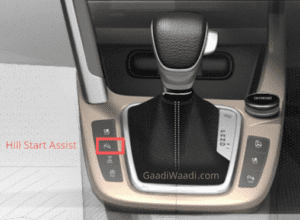
Hill Assist, also known as Hill Start Assist or Hill Hold Control, is a feature found in many modern vehicles, particularly those with manual transmissions or automatic transmissions with manual mode. Hill Assist is designed to assist drivers when starting from a stop on a steep incline or hill. Here’s how Hill Assist works and why it’s beneficial:
How Hill Assist Works:
- Detection of Hill: When the vehicle comes to a stop on an incline, the Hill Assist system uses sensors, such as the vehicle’s accelerometer, to detect the angle of the slope.
- Brake Holding: Once the system determines that the vehicle is on a hill, it engages the brake system to hold the vehicle in place. This prevents the car from rolling backward while the driver moves their foot from the brake pedal to the accelerator.
- User-Friendly: Hill Assist provides the driver with a few seconds of brake holding time (typically 2-3 seconds) to smoothly accelerate and prevent the vehicle from rolling back.
- Disengagement: Hill Assist automatically disengages once the driver begins to accelerate or after a set time period. This allows the vehicle to move forward without any hindrance from the braking system.
Benefits of Hill Assist:
- Prevents Rollback: The primary benefit of Hill Assist is that it prevents the vehicle from rolling backward when starting on a hill. This can be especially helpful for drivers of manual transmission vehicles who may otherwise struggle with the clutch and throttle coordination needed to prevent rollback.
- Reduced Stress: Hill Assist reduces the stress and anxiety often associated with hill starts, particularly for new or inexperienced drivers. It provides a sense of security and makes hill starts smoother and more controlled.
- Improved Safety: By preventing rollback on steep inclines, Hill Assist reduces the risk of accidents caused by a vehicle rolling into the vehicle behind it.
- Manual and Automatic Use: Hill Assist is useful for both manual and automatic transmissions, making it a versatile feature for a wide range of vehicles.
- Convenience: It adds a level of convenience, especially in traffic situations where frequent hill starts are required, such as in hilly urban areas.
- Adaptive Systems: Some advanced Hill Assist systems can adapt to the steepness of the hill and provide more or less brake holding time accordingly.
It’s important to note that while Hill Assist is a valuable feature, it should not replace the driver’s skill and knowledge of how to perform hill starts safely. Drivers should still be familiar with proper clutch and throttle control (for manual transmissions) and use the feature as an aid rather than a sole reliance when starting on hills. Additionally, Hill Assist may not be available on all vehicles or trim levels, so it’s worth checking if your vehicle is equipped with this feature.
Blind Spot Monitor
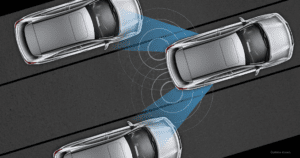
A Blind Spot Monitor (BSM) is a safety feature commonly found in modern vehicles that helps drivers be aware of and avoid potential collisions with vehicles or objects in their vehicle’s blind spots. Blind spots are areas around a vehicle that are not visible to the driver through the standard rearview mirrors. Here’s how a Blind Spot Monitor works and why it’s beneficial:
How Blind Spot Monitor Works:
- Sensor Placement: Blind Spot Monitors typically use sensors, such as radar or ultrasonic sensors, positioned on the sides of the vehicle, often near the side mirrors. Some systems may also use cameras for this purpose.
- Detecting Nearby Objects: The sensors continuously monitor the adjacent lanes on both sides of the vehicle. They can detect the presence of vehicles or objects in these areas, even if they are outside the driver’s field of vision.
- Indicator Alerts: When the system detects a vehicle or object in the blind spot, it activates a visual or audible alert to warn the driver. This alert is usually displayed on or near the side mirror on the side where the object is detected. In many vehicles, it appears as a small icon or light.
- Activation Conditions: Blind Spot Monitors are typically activated when the vehicle is in motion, typically at speeds above a certain threshold, such as highway speeds. Some systems may also take into account factors like turn signal usage or steering wheel movement.
- Driver Response: Upon receiving a Blind Spot Monitor alert, the driver is prompted to check the corresponding side mirror or perform a visual check of the blind spot before changing lanes or making a maneuver. The purpose of the alert is to enhance the driver’s situational awareness.
Benefits of Blind Spot Monitors:
- Improved Safety: BSM enhances safety by reducing the risk of collisions caused by lane changes or merges when another vehicle is in the blind spot. It helps prevent dangerous situations, such as side-swipe accidents.
- Reduced Driver Stress: Drivers often need to check their blind spots by turning their heads to ensure safe lane changes. BSM reduces the need for such physical checks, making driving less stressful.
- Enhanced Convenience: Blind Spot Monitors are especially useful in heavy traffic or on crowded highways, where vehicles may frequently enter and exit adjacent lanes.
- Additional Features: Some BSM systems are integrated with other safety features, such as Rear Cross-Traffic Alert, which warns the driver when a vehicle is approaching from the side, such as when backing out of a parking space.
- Increased Awareness: BSM serves as an extra set of “eyes” for the driver, helping to alert them to the presence of vehicles or obstacles they might otherwise overlook.
It’s important to note that while Blind Spot Monitors are valuable safety features, they are not a substitute for proper driving practices and mirror use. Drivers should always visually check their blind spots and mirrors before making lane changes or merging, even when equipped with a BSM. Blind Spot Monitors are intended to complement the driver’s awareness and assist in avoiding accidents, but responsible driving remains essential.
Heads up display HUD :
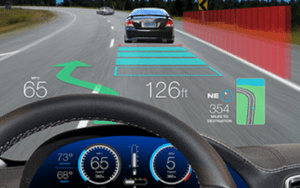
A Heads-Up Display (HUD) is a transparent or semi-transparent display system that presents essential information to the user, typically in an easily viewable location without requiring them to look away from their usual line of sight. HUDs are commonly used in various applications, including automotive, aviation, military, and augmented reality (AR) devices. Here’s an overview of how a HUD works and its applications:
Components of a HUD:
- Projector: The HUD system includes a projector that displays information onto a transparent surface, such as a specially coated windshield or a separate transparent screen.
- Optical System: An optical system, often using mirrors or lenses, is used to project the information onto the display surface in a way that makes it appear as if it’s floating in the user’s field of view.
- Display Content: The information displayed on the HUD can vary widely depending on the application. In vehicles, it often includes data like speed, navigation directions, and warnings. In aviation, HUDs display critical flight information like altitude, airspeed, and heading. In augmented reality glasses, HUDs can overlay digital information onto the user’s view of the real world.
How a HUD Works:
- Information Generation: Data or information from various sources, such as vehicle sensors, navigation systems, or aircraft instruments, is collected and processed.
- Projection: The processed information is sent to the HUD’s projector.
- Optical Projection: The projector projects the information onto the transparent surface, which reflects the data into the user’s field of view. This reflection typically occurs at a specific angle, so the information appears to be in front of the user without obstructing their view of the surrounding environment.
- User Viewing: The user can see the displayed information as if it’s floating in the distance, allowing them to stay focused on the task at hand without having to shift their gaze away.
Applications of HUDs:
- Automotive HUDs: In cars, HUDs show critical driving information like speed, turn-by-turn navigation, lane departure warnings, and more on the windshield. This helps drivers keep their eyes on the road while accessing essential data.
- Aviation HUDs: In aircraft, HUDs provide essential flight data, navigation cues, and target information directly in the pilot’s line of sight, improving situational awareness and safety, especially during poor visibility conditions.
- Military HUDs: Military aircraft and ground vehicles often use advanced HUD systems for targeting, night vision, and mission-critical data presentation.
- Augmented Reality (AR) HUDs: AR glasses and smart helmets use HUD technology to overlay digital information, such as maps, notifications, or augmented reality graphics, onto the user’s real-world view.
- Marine and Nautical HUDs: Some boats and ships use HUDs for navigation and safety information, helping sailors maintain their awareness of surrounding water conditions.
- Sports and Recreation: Some sports and recreational activities, like cycling and skiing, have HUD-equipped helmets that display performance metrics and navigation directions.
Heads-Up Displays enhance safety and convenience across various industries by providing users with vital information without the need to divert their attention from the task at hand. Their use continues to evolve and expand as technology advances, providing users with more sophisticated and useful data in real-time.
Free Repair Manuals
Get access to a wide range of free factory auto repair manuals PDF for all your automotive repair and service needs.

